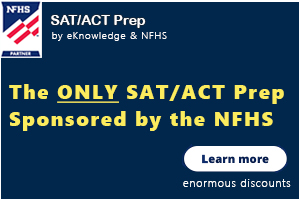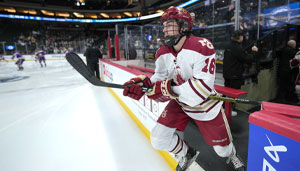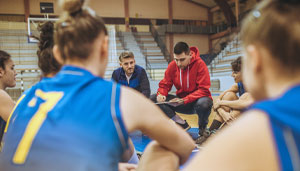The Importance of Having Appropriate Personnel at Events
By Edward Hill, Jr. on December 04, 2024 hst PrintWhen you look at a sporting event or an event involving the arts, do you ever wonder how many people it takes to ensure that everything goes smoothly? While most know that it takes a reasonable amount of money, they may not realize the most important factor in putting on the event: the personnel.
Looking at the state high school associations across the United States, each Association puts on state championships, as well as some school recitals and plays. Each association relies on many individuals to ensure that not only does the event run smoothly, but that the appropriate amount of space is allotted, ensuring that the participants are safe.
The event planning starts months before the final product. It begins with the personnel of the associations behind the scenes and the individuals during the event/production.
One of those state high school associations is the District of Columbia State Athletic Association (DCSAA), which offers a unique model for athletics administration in its approach. The association was formed in 2012 to combine sports and athletics in both high school and middle school in the District of Columbia.
It features the inclusion of boys and girls sports from public, private and charter school programs. In those 12 years, the DCSAA has expanded to 35 sports in the high school and middle schools in Washington, DC. The schools are grouped as Class A and Class AA.
The DCSAA staff consists of seven individuals who manage the day-to-day operations, led by Kenneth Owens, the current executive director of the association. A former athlete, Owens was part of the formation as an assistant before taking over four years ago. Owens discusses the plan of action for the DCSAA as it pertains to the playoffs and championships:
"Right now, we have 35 sports where we have championships,” said Owens, a former soccer player at Georgetown University. "Before the academic school year, we sit down and look at dates and possible sites for our championship which is divided into three categories: fall, winter and spring.
“As for the various sites, we prefer the facilities of local colleges and universities. We found that they are better equipped to host the events, and it also gives the young people a chance to get eyes on them.
“We do a thorough walkthrough of all the facilities and venues selected. That includes factors such as two sides of seating for fans of both teams. Also, we have to make sure that qualified personnel are assigned for the various duties and responsibilities."
Selection of Officials
"All of our officials are certified by DCSAA,” Owens continued. “That includes them passing the test and background checks. We rely on the various boards that govern the sports to assist us.”
Owens added that one of the assistants, Sean Conley, is a former basketball official and assists in the selection and statewide program coordinator of athletics, as he attends various events during the season to evaluate the officials, specifically in the sports of basketball and football. Owens says that he plays a significant role in the selection of soccer officials.
Support Staff
In addition to Owens and Conley, the DCSAA benefits from staff member, Josh Barr, who manages media and other communications. Barr was a former high school sportswriter for the Washington Post for 17 years. He is the primary source of contact for all communications for championship events.
Barr is responsible for the printing of the Gameday programs that include the names and numbers of athletes and highlights of the athletes and coaches. This is always a challenge depending on whether there are updates of rosters (including correct numbers).
Operations Staffing Assigned to Championships Events
Much like the officials, the DCSAA selects personnel from the local area who are experienced and proficient in clock operating, statistician, and the various other assigned duties essential to a smooth event.
Medical and Ambulance
When it comes to staging state championships, no group of individuals is more important to state high school associations than medical personnel, including certified athletic trainers.
As mentioned above, one of the vital components but also one that is often forgotten, to the functioning of athletics in athletic training. When it comes to sports and athletics at any level, it becomes almost an afterthought.
Yet, what would happen if it was not available to the injured or distressed athletes who compete? In case of injury, there would be no athletes to compete.
Such was the case in Washington, D.C. back in the 1980s, which resulted to legal actions.
In August 1989, Parents United for the D.C. Public Schools sued to enforce the District of Columbia Public School Nurse Assignment Act of 1987, requesting both declaratory and injunctive relief. The Nurse Assignment Act requires the District of Columbia to assign a registered nurse to each elementary and secondary school for a specified number of hours and to assign either a registered nurse or a certified athletic trainer to attend every school-sponsored athletic event.
The trial court granted summary judgment for Parents United on both the statutory and the constitutional claims, granted permanent injunctive relief ordering compliance with both requirements of the Act.
Jennifer Rheeling (MS, LAT, ATC), who has served in athletic training with the District of Columba State Athletic Association, which governs high school and middle schools in the District of Columbia and the DCIAA for more than 30 years. She has served on numerous boards and as a liaison for athletic training and is greatly respected in the profession.
When asked about the role and importance of athletic trainers in high school and middle school, she offers the following:
“Athletic trainers (ATs) are important at athletic events because we are experts in risk mitigation dedicated to health and safety with an eye to emergency preparedness. Not only are we able to prepare student-athletes to compete safely, but our expertise also allows us to appropriately manage injuries that occur on-site, complete sideline evaluations, make return-to-play decisions, and provide necessary accommodations such as wound management, taping and bracing, etc. ATs are the only personnel not distracted by other responsibilities and come fully prepared for both the mundane and for emergency response. Athletic trainers know the value of preparation over hindsight. We come equipped with emergency action plans, hold pre-event medical meetings, and ensure all equipment is present and in working order. However, the definition of events needs to expand to encompass all athletic activities including practices, conditioning sessions, etc. Emergencies do not discriminate.”
Rheeling adds that there have been a number of changes due to the rapid growth of athletics and sports across the country. It has increased the demand for more personnel to serve.
For those who are considering pursuing a career in athletics, Rheeling says that are four basic rules to follow:
- Be prepared
- Manage details
- Have an emergency plan
- Look for solutions.
Though often overlooked but not a requirement in most states, it is strongly encouraged to have a certified athletic trainer at the athletics events since they can not only help to quickly aid with injury but can also save a life.
Use of Interns and Volunteers
Owens says that the DCSAA uses interns and volunteers from sports management programs at the local Universities.
"Sports and athletics are a growing profession,” Owens said. “We want to make it a win-win situation. We can always use extra help. This gives them [interns] an opportunity to use it as a steppingstone for their futures."
While understanding the ins and outs of putting on a sports-related event, when it comes to hosting a non-sports-related event, there are some important considerations to ensure a smooth event, such as who is going to run the equipment needed, what experience level they will need and who will be operating the curtains, etc.
Neal Downing has served as director of athletics at Alice Deal Middle School in Washington, DC for the past 14 years, and is also responsible for the effective operation of the various non-sport-related events held at the school. Because Alice Deal has one of the largest facilities among middle schools in the city, it is very much in demand to host musicals, plays and dance recitals. The numbers, roles and duties of the individuals involved in the production should have a mandatory meeting and walkthrough before the event.
“We have to all be on the same page as it relates to the effectiveness of the operation,” noted Downing. “Before the personnel is decided upon, the most important thing is to establish a building lease agreement for the requested day, time and length of the event, which will allow those putting on the production to understand just how many people it will take.”
Downing offers his modus of operandi for holding these types of events:
"The most important factor is to establish the number of expected attendees and participants at the event so that we can make sure our personnel can accommodate whatever their specific needs are. It is extremely important to avoid any potential crisis of understaffing or under-resourcing."
Downing adds that other important factors include:
- Whether it is a paid event, how the money will be collected, and who will oversee that responsibility.
- Does there need to be security present and, if so, is the host responsible or are the participants responsible for compensating the security?
- Assigned personnel in charge of lighting, sound and speakers and the operating of the curtains.
- The roles of the custodial crew, and the staffing of personnel responsible for accommodations for any media that might be covering the event.
In all, no matter the event, sport or non-sport, personnel are the most important entity of them all.
Edward Hill, Jr.
Edward Hill, Jr. served as Director of Communications at Howard University for 33 years from 1983 until 2017. Hill currently covers community, high school, college and professional sports for the Washington Informer.
Most Recent Articles
- Track & Field/Cross Country article The Role of the Starter in a High School Meet
- nfhs news NFHS, NCAA, SFIA put on 2025 Team Sports Conference
- nfhs news Coaching Mental Wellness Course Now Offered on NFHS Learning Center
- nfhs news Final Four Participants Hope to Repeat State Championship Experiences
- nfhs news Former NFHS Assistant Director Susan True Passes Away







